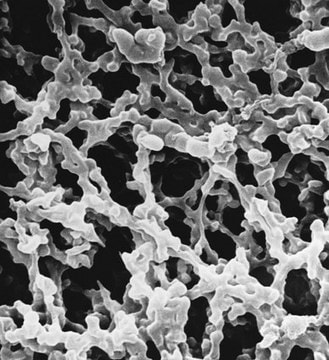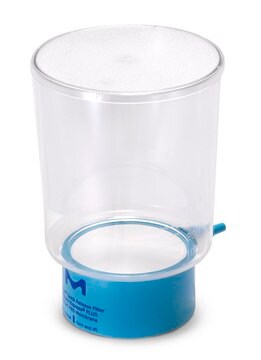MAB5228
Anti-Amyloid Precursor Protein Antibody, Secretory, clone OM84
clone OM84, Chemicon®, from mouse
Synonym(s):
APP
Sign Into View Organizational & Contract Pricing
All Photos(1)
About This Item
UNSPSC Code:
12352203
eCl@ss:
32160702
NACRES:
NA.41
clone:
OM84, monoclonal
application:
ELISA
WB
WB
species reactivity:
human
technique(s):
ELISA: suitable
western blot: suitable
western blot: suitable
citations:
1
Recommended Products
biological source
mouse
Quality Level
antibody form
purified immunoglobulin
antibody product type
primary antibodies
clone
OM84, monoclonal
species reactivity
human
manufacturer/tradename
Chemicon®
technique(s)
ELISA: suitable
western blot: suitable
isotype
IgG2aκ
NCBI accession no.
UniProt accession no.
shipped in
dry ice
target post-translational modification
unmodified
Gene Information
human ... APP(351)
Specificity
Reacts with secretory amyloid precursor protein (sAPP), but not with Amyloid-Beta protein 1-40.
Immunogen
Amyloid Precursor Protein (APP) secreted by the EJ-1 bladder carcinoma cell line.
Epitope: Secretory
Application
Anti-Amyloid Precursor Protein Antibody, Secretory, clone OM84 detects level of Amyloid Precursor Protein & has been published & validated for use in ELISA & WB.
Research Category
Neuroscience
Neuroscience
Research Sub Category
Neurodegenerative Diseases
Neurodegenerative Diseases
Western blot: 10 μg/mL ELISA: 1 μg/mL
Optimal working dilutions must be determined by end user.
Optimal working dilutions must be determined by end user.
Physical form
Format: Purified
Protein A Purified mouse immunoglobulin in 10 mM sodium phosphate buffer (pH 7.4), 0.15 M NaCl, and 0.1% sodium azide as a preservative..
Protein A purified
Storage and Stability
Maintain frozen at -70°C or below in undiluted aliquots for up to 12 months, avoid repeated freeze/thaw cycles.
Analysis Note
Control
Brain
Brain
Other Notes
Concentration: Please refer to the Certificate of Analysis for the lot-specific concentration.
Legal Information
CHEMICON is a registered trademark of Merck KGaA, Darmstadt, Germany
Disclaimer
Unless otherwise stated in our catalog or other company documentation accompanying the product(s), our products are intended for research use only and are not to be used for any other purpose, which includes but is not limited to, unauthorized commercial uses, in vitro diagnostic uses, ex vivo or in vivo therapeutic uses or any type of consumption or application to humans or animals.
Not finding the right product?
Try our Product Selector Tool.
recommended
Product No.
Description
Pricing
Storage Class Code
12 - Non Combustible Liquids
WGK
WGK 2
Flash Point(F)
Not applicable
Flash Point(C)
Not applicable
Certificates of Analysis (COA)
Search for Certificates of Analysis (COA) by entering the products Lot/Batch Number. Lot and Batch Numbers can be found on a product’s label following the words ‘Lot’ or ‘Batch’.
Already Own This Product?
Find documentation for the products that you have recently purchased in the Document Library.
Dual roles of the transmembrane protein p23/TMP21 in the modulation of amyloid precursor protein metabolism
Vetrivel, Kulandaivelu S, et al.
Mol. Neurodegener., 2, 4-4 (2007)
A novel actin-binding domain on Slo1 calcium-activated potassium channels is necessary for their expression in the plasma membrane.
Zou, S; Jha, S; Kim, EY; Dryer, SE
Molecular Pharmacology null
Christine Römer et al.
The Journal of neuroscience : the official journal of the Society for Neuroscience, 35(20), 7777-7794 (2015-05-23)
Stroke-induced immunodepression (SIDS) is an essential cause of poststroke infections. Pharmacological inhibition of SIDS appears promising in preventing life-threatening infections in stroke patients. However, SIDS might represent an adaptive mechanism preventing autoreactive immune responses after stroke. To address this, we
Ellen Sapp et al.
Neurobiology of disease, 141, 104950-104950 (2020-05-23)
Molecular changes at synapses are thought to underly the deficits in motor and cognitive dysfunction seen in Huntington's disease (HD). Previously we showed in synaptosome preparations age dependent changes in levels of selected proteins examined by western blot assay in
Our team of scientists has experience in all areas of research including Life Science, Material Science, Chemical Synthesis, Chromatography, Analytical and many others.
Contact Technical Service





